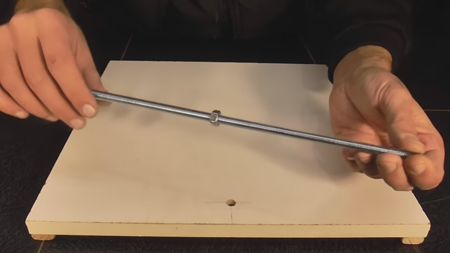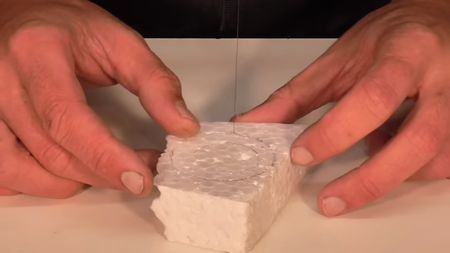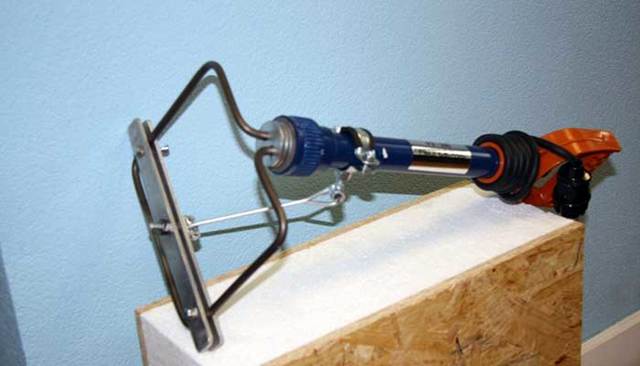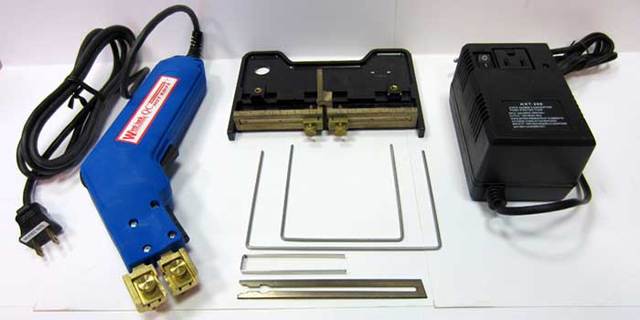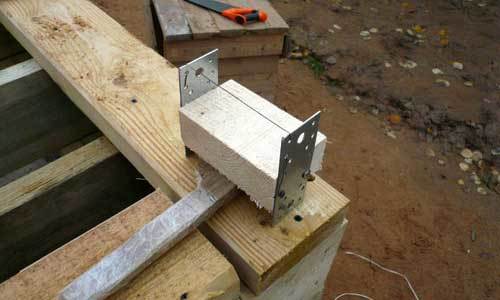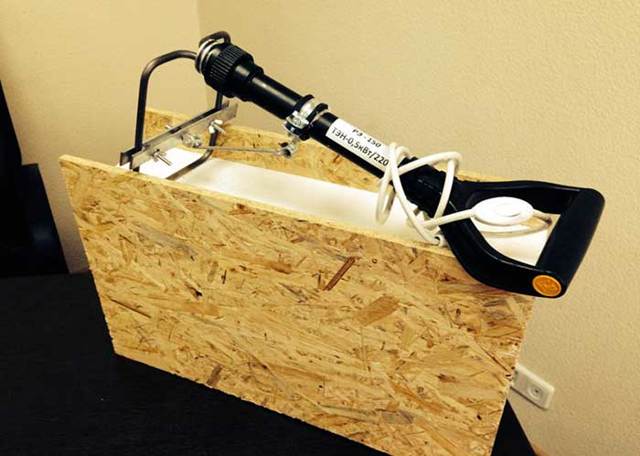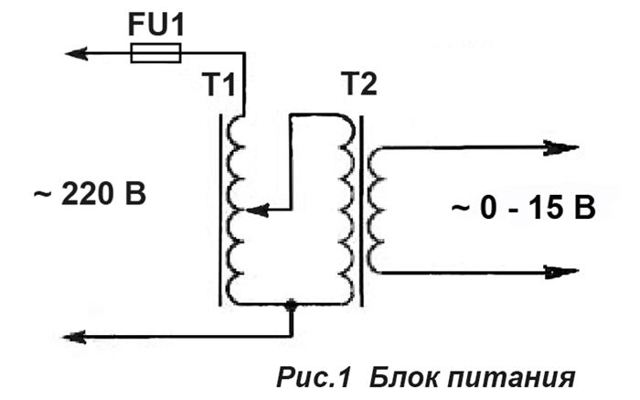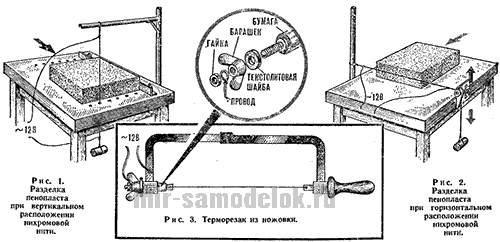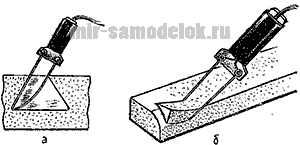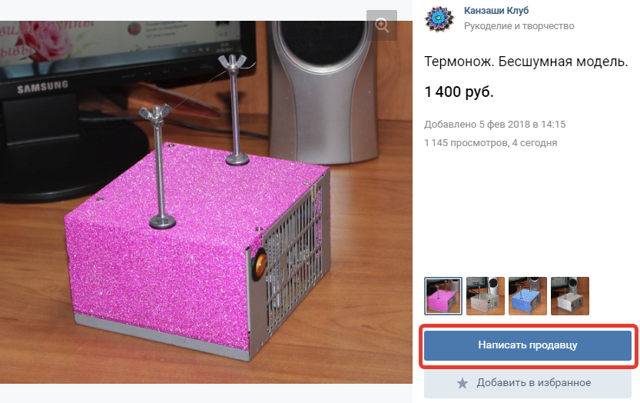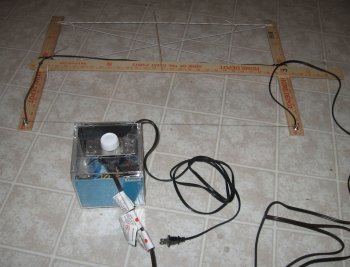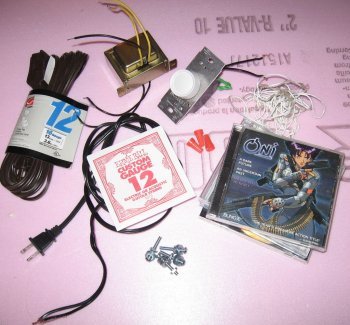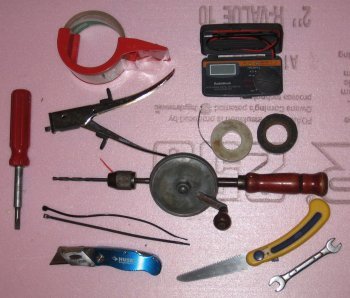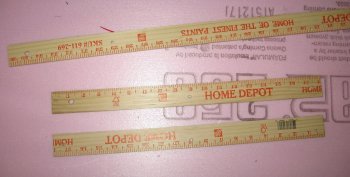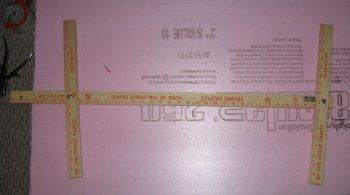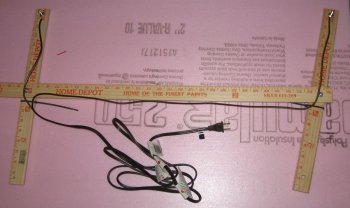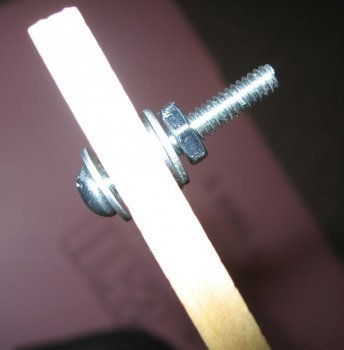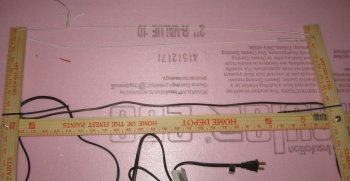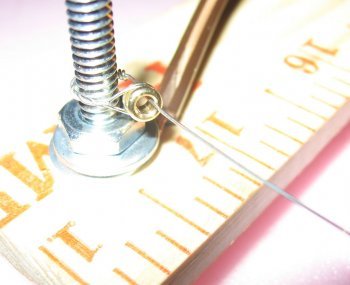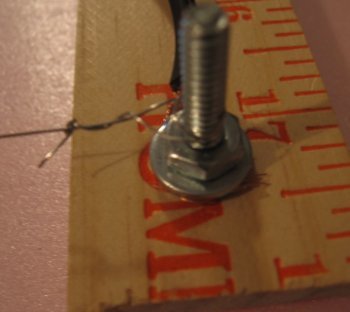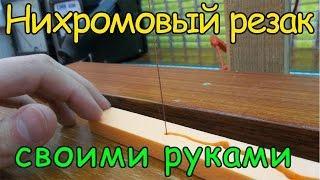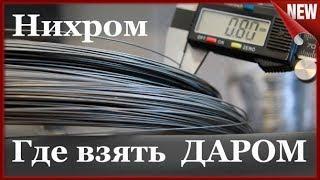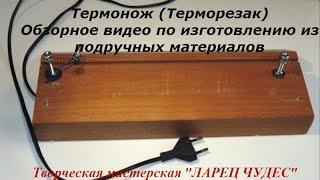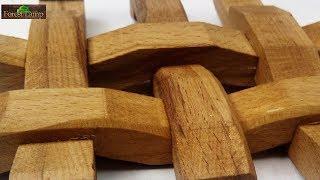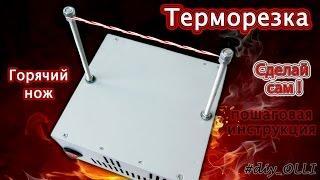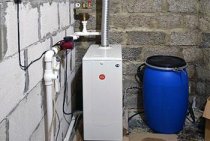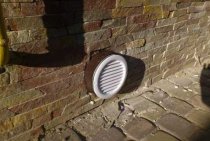Thermal foam cutter video
This video is about how to make a thermal cutter, which is useful for various purposes in the workshop. For example, you need to cut the foam or foam rubber evenly. An electric knife is perfect for this task!
For the future bed of the thermal cutter, take a piece of chipboard from old furniture. By design, this table needs legs. Next, drill two holes with a drill. Take a drill with a slightly larger diameter and make a recess for the countersunk head. Now everything is ready to tighten the legs with screws. It turned out a small table for the future cutter.
Now, with a pencil and a ruler, mark the place where the holes are needed. Take a drill with a diameter of 8 millimeters and make a through hole. A frame for stretching a nichrome thread will be mounted in it. In the center of the table you need to make another hole. It will be much smaller in diameter than the previous one. Drill diameter 1 mm. Made a through hole.
Now you need a stud with an m8 thread. Saw off from it a segment along the length. After a certain distance, we bend the hairpin with the letter G. So that the hairpin does not burst during operation, you need to warm it up a little. It's a 90 degree angle.
Now you can screw a powder nut onto the thread of the stud. It is needed for convenient fixation of the frame to the table. After the nut, put on the washer. You will need a bronze adapter with two screws to secure it. We fix the adapter in the holes that we drilled in the center.
Electronics for DIYers in a Chinese store.
Of course, a powerful wire is needed to power the device. You will also need a power button. We clamp one end of the wire in the adapter. Solder a contact washer on the other end. Now you can fix it so that it is securely attached to the structure, and the contacts do not break at the base.
In the hole in we mount a frame made of studs. We put two washers in the lower part of the table, first the thrust one, and then the contact one. Now you can tighten the nut. That's all. We clamp it with a wing nut and the frame is securely installed on the table.
Connect a switch to the gap of one wire. Cut off the excess piece of wire. We clean the wires. Screwable button. The switch is connected. It can be collected on site.
First we thread the thread into the hole, we fix one end of the spiral into the adapter. We fix on the mounting bolt. With a big stretch, we place the spiral between 2 washers. We fix the contacts with a wing nut. That's all! The cutter is ready! It can be checked.
Power connected - battery charger. With this device, you can easily and accurately cut the foam. To make the cut more even and accurate, use a guide. The cutter did a great job with the foam! No less successful with cutting foam rubber. Let's try to cut a plastic bottle. The thermal cutter cuts plastic parts well.
Do-it-yourself thermal knife for SIP panels
The construction of SIP panels using Canadian technology gives a lot of advantages to the happy owners of a new home. However, everyone wants to give their project elegance, style, not limited to faceless rectangular structures. This requires cutting panels, the formation of parts of complex configuration.
If the project is ordered from a contractor company, there will be no problems. But if the construction is carried out independently, special equipment will be required, in particular, a thermal cutter.
Panel cutting
SIP panel is quite easy to modify. When construction is carried out independently, cutting occurs as follows:
- two surfaces of OSB panels are cut with a jigsaw or a circular saw;
- along the cut line, the part of the panels that is consumed is simply broken off.
The main problem remains: to form a groove for mounting the strapping beam.
To do this, they often use a grater, planer or cutter, which simply removes the required amount of SIP panel filler in small portions.
At the same time, do-it-yourself work is not difficult, however, the construction site is littered, filled with fine “snow” from filler particles that are constantly moving and difficult to remove.
What makes a groove in SIP panels
To make a groove in SIP panels, there are two methods:
- industrial, using a machine-type cutter that removes the filler with knives, with forced removal of waste;
- using heat treatment, a cutter is used that gently melts the filler and allows you to immediately form a groove of the desired depth.
Today, enough models are sold, you can buy a thermal knife, which will be regulated in power, temperature, and allow the formation of a groove of the desired depth. However, such a tool can be made by hand. The design of the knife is not difficult, so it is easy to repeat it in a handicraft.
How to make your own thermal knife
The temperature effect knife should have the following functionality:
- temperature control of the cutting part;
- the thermal knife must necessarily allow you to adjust the depth of the groove;
- the design must be such that the knife can be used without carrying out preliminary work after cutting the SIP panels.
Important to know: Standard sizes of SIP panels
Despite the apparent complexity of the task, making such a thermal knife is quite easy. With it, cutting SIP panels with your own hands will be simple and fast. To create a device you will need:
- two strips of hard steel or fiberglass of small thickness. Their strength depends on the required depth of the groove to be obtained;
- nichrome wire, with which the knife will melt the filler;
- a plate that will act as a limiter, setting the thickness on which the cut will be made.
It is easy to use a powerful battery charger as a power source, which allows you to adjust the voltage on the thread. Naturally, to make a thermo knife with your own hands, you will need a comfortable handle that will hold the side plates of the cutting part.
Assembling a thermal knife
Assembling the structure with your own hands is very simple. Voltage from the power supply can be applied to a nichrome wire by soldering it to the contacts where the voltage supply wires fit. And with a small thickness of steel plates, you can supply power to them, while the wire can simply be screwed at the bottom, you only need to drill two holes.
The initial rigidity of the structure is set by the handle block. Each side plate is attached to the corners with two bolts located vertically. Increases the rigidity of the restrictive bar.
For example, it can be simple bolts and U-shaped brackets worn on the side parts.
Conclusion
Despite the simplicity of the design, the thermal knife for processing the filler of SIP panels works very efficiently, even if it is made by hand. Due to the small thickness of the side plates, the need to form a side cut can be eliminated, especially since it is possible to sharpen the edge of these parts if they are made of steel.
Important to know: Are SIP panels harmful to health?
Nichrome thread with the help of a voltage regulator has the desired temperature (selected empirically) for quick selection of the groove. As a result, such a cutter can guarantee fast work and cleanliness on the construction site. In addition, such a thermal knife will cost just a few tens of rubles and can be assembled using existing equipment.
Do-it-yourself foam cutter thermal cutter
Homemade tools for cutting foam
- Power supply for homemade thermal cutters
- Homemade cutter for working with flat sheets of foam
- Homemade thermal cutter for curly cutting
- Homemade thermal cutter from a soldering iron
Styrofoam is a light, technological and durable material, which also has low thermal conductivity, is a godsend for a builder or a home craftsman.
It can be used not only as a heater, but also as a structural material for the formation of a wide variety of models, blanks, forms, etc.
But foam is produced in the form of rather large blocks, when cutting with a knife or saw, the material crumbles due to the destruction of its structure.
Figure 1 - Scheme of an adjustable power supply.
An electric foam cutter, the working element of which is usually a nichrome wire heated to a temperature of several hundred degrees, cuts the foam neatly, evenly and without crumbs. This happens because, upon contact with the heated wire, the foam instantly melts, forming a strong sintered cut.
In this article, you can get acquainted with the designs of homemade foam cutters for various purposes.
Power supply for homemade thermal cutters
Figure 2 - Diagram of a cutter that allows you to cut flat sheets from a block of foam.
The power dissipated on a nichrome wire at a given heating temperature depends on its length and cross-sectional area. It is better if the wire is thin enough (0.1-0.2 mm).
Its cold resistance is on the order of a few ohms. The operating temperature corresponds to the beginning of the reddening of the wire.
With a wire length of 50 cm, about 50 W of power is dissipated on it at a current of about 5 A.
If the foam cutter is used only occasionally, a battery can be used as a power source. Sometimes it is even more convenient, and from a safety point of view, better than using a mains power supply. The glow of the filament can be adjusted by changing the number of batteries connected in series.
But when working systematically with cutters, a universal AC power supply is preferable. It is not difficult to make such a source with your own hands. Its basis is a step-down transformer, designed for a power of at least 100 W, having a secondary winding designed for a voltage of 15 V. The diameter of the wire with which it is wound must be at least 1.5 mm.
To smoothly change the current, you can, of course, use a suitable rheostat or make a secondary winding with taps and put a switch.
But the most convenient option is to use an autotransformer with continuously adjustable output voltage (LATR), to the output of which a step-down transformer is connected.
A diagram of such an adjustable power supply is shown in fig. 1. Here T1 is LATR, and T2 is a step-down transformer.
Homemade world
Rating: 5 / 5
Methods for cutting large sheets of foam. The nichrome thread is suspended vertically (Fig. 1) or stretched horizontally to the table surface (Fig. 2).
By adjusting, in the first case, the distance from the thread to the movable guide angle and, in the second case, the height and angle of the thread relative to the table surface, it is possible to obtain workpieces of any shape and size.
The expansion of the thread during heating is selected using a weight.
By changing the distance between the moving contacts-clamps (like "crocodile"), they regulate the glow of the thread. When working with small foam blanks, there is no need to make a special frame to fix the nichrome thread.
To do this, you can use an ordinary jigsaw or hacksaw, replacing the nail file or canvas with nichrome thread (Fig. 3). In this case, it is necessary to carefully isolate the current-carrying contacts on them.
Isolate the moving part of the hacksaw, which regulates the thread tension, from the body with asbestos or a paper gasket, and the tension lamb with a textolite washer.
Thermal cutter for figured cutting of polyfoam.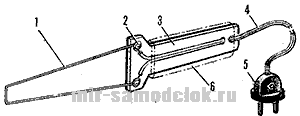
| Rice. 4.Thermal cutter device: 1 - nichrome wire (a spiral from an electric stove), 2 - a screw with a nut and a washer, 3 - a handle (textolite S 4 mm), 4 - an electric cord, 5 - a plug, 6 - a rubber or vinyl chloride tube. |
The thermal cutter allows you to make indentations, cut cavities in the thickness of the material and generally handle the foam in the same way as a sculptor handles clay. After such processing, a thin melted crust remains on the surface, which increases the rigidity and strength of the foam and closes its pores. You can make a step-down transformer yourself. To do this, you need transformer iron Ш20Х24. The primary winding contains 1600 turns of wire PEV-1 0.39 (or PEV-1 0.44), and the secondary - 50 turns of wire of the same brand and 1.0-1.1 mm thick. To select the current value, make a rheostat (a pre-stretched spiral from an electric stove is suitable for it). For the winding frame, use a suitable asbestos-cement or ceramic tube 0 10-15 mm and about 80 mm long. Nichrome wire should be wound until the frame is filled. If you are seriously interested in curly cutting foam, then it makes sense to prepare several of these cutters (Fig. 6) with different tips.
Rice. Fig. 7. Some methods of working with a thermal cutter: a - formation of a cavity, b - chamfering.
Thermal cutter for tapes advantages and disadvantages, how to make, where to buy
In the past few years, a thermal cutter or thermal knife has become an indispensable tool for needlewomen working with ribbons, felt, and foamiran. What is a thermo knife? This is a power tool that can heat a stretched nichrome wire, which allows you to easily, quickly and evenly cut tape, felt, foamiran and even foam.
Advantages and disadvantages of a hot knife
The hot knife is actively used by craftswomen using the kanzashi technique. It cuts and simultaneously seals the tape in one or more layers. With it, you can cut the ribbon into squares, make petals with even cuts, without using a candle and scissors. The edges of the thermally cut tape remain smooth, without black deposits, as is the case with a candle.
The thermal knife greatly simplifies the creation of multilayer petals. With it, you can easily create a petal from 10 more layers of tape.
The thermal cutter is used not only for tapes, but also for other synthetic materials. For example, using a thermal cutter, you can cut felt mugs, which are used in kanzashi as the basis for jewelry.
This can be easily done using a metal template of the desired diameter. Felt cuts just as easily as ribbon.
Also, with a thermal knife, you can cut any object according to a template from foamiran or cut a foam blank.
The advantages of thermal cutting are obvious:
- There is no need to use a candle and scissors - the thermal knife cuts and melts at the same time.
- The cuts on the petals are even, without black soot.
- The speed of cutting ribbons or creating kanzashi petals increases significantly.
- Ideal for creating layered petals.
The disadvantages of a hot knife should also be noted:
- Electricity consumption.
- Some materials, such as organza and brocade ribbon, when cut with a hot knife, leave a peculiar odor that can provoke a coughing reaction.
- Not all types of petals can be made. Some types of flower petals can only be crafted using an open fire.
- Private production. As a rule, thermal cutters are produced by private craftsmen, respectively, these devices are not certified, they are not provided with an official guarantee, quality claims will have to be made by an ordinary person, and not by an organization, the fact of purchase cannot be proved.
How to make a thermal cutter for ribbons with your own hands
You can assemble a thermal knife for cutting ribbons with your own hands, well, or with the hands of your husband. There are dozens of videos on the Internet on how to make a thermal cutter for kanzashi yourself.In most cases, not so many details are required - a power supply from a computer, a wire, preferably with a dimmer to control the heating temperature of the wire, nichrome wire, 2 bolts and nuts.
Where to buy a thermal cutter for ribbons
If you don’t have the opportunity to assemble a thermal cutter, then take its purchase responsibly, namely:
You can buy a thermal cutter in our group on VKontakte - Kanzashi Club. We have already asked all the above questions to the manufacturer who assembles thermal knives and his answers satisfied both us and our customers.
Do not forget that cutting the tape with a hot knife requires safety precautions:
- there should not be flammable objects near the working thermal cutter;
- the surface of the device should be kept clean, especially if there is a ventilation hole on top, into which the remnants of tapes can fall;
- The tape should be cut using metal templates or tweezers, otherwise you may get burned;
- The hot knife should be switched off after 20 - 30 minutes of continuous operation. Let it cool down a bit.
If you have any questions or suggestions, write in x under the post, I will be happy to answer.
Do-it-yourself thermal cutter for foam plastic BigHandMade
An American craftsman from Portland has made an amazing device that can expertly process pieces of foam. With it, you can create various models and figures for board games.
Step 1: Materials
Wire with a diameter of 1.3 mm (3.6 m long).
2 measuring rulers.
4 screws (see picture).
Rope (3.6 m).
Rheostat with switch.
Transformer for 25 V and 2 A.
Electric guitar string.
Wire with plug.
4 CD boxes (optional).
Step 2: Tools
Knife.
Screwdriver.
Saw.
Cable ties.
Insulating tape.
Multimeter.
Cutting scissors.
Pliers.
Wrench 9 mm.
Soldering iron.
Step 3: Frame
Cut the line in half. In each half, make holes in the middle, as well as from 2 ends (see photo).
In the second ruler, make holes at one end and 15 cm to the right of this point.
Step 4: Connection
We make a frame in the form of the letter "H", as shown in the photo.
- Step 5: Wires
- We clean the ends of the wires and fix them with the help of screws and nuts, focusing on photos 1 and 2.
- Use cable ties to keep the wires tightly against the frame.
Step 6: Loop
We pass the rope between the 2 ends of the rulers, pulling the loop.
Step 7: Strings
We tie the ends of the string from the electric guitar around the screws and pull it between them using pliers. The tension should not be too tight.
- Step 8: Crossing
- We stretch the rope crosswise, as shown in the photo.
- We wrap the nuts on the axial 2 screws with a wrench.
- Step 9: Tension
- Adjust the rope tension.
- Step 10: Transformer
- Connect the wires, transformer and rheostat to the circuit.
- Step 11: Box
It is better, of course, to find a good container for the transformer. But boxes of 4 CDs, sealed with tape, are also quite suitable.
- Step 12: Connecting
- The device should be kept away from flammable substances, fabrics and carpets.
We switch the rheostat and check with a multimeter whether the current is flowing through the string. It should heat up and cool down in seconds.
- Step 13: Examples
- In the photo you can see several foam crafts made using a thermal cutter.
Do-it-yourself thermal cutter in 30 minutes Easy
Views: 25 448
Watching now
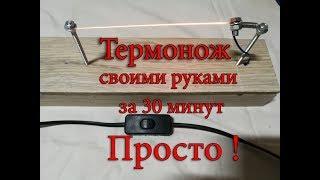
1 year ago
25 448 views 
4 months ago
19 790 views 
8 years ago
66 596 views 
7 years ago
32 445 views
See below
Dmitry Izumov
1 year ago
Julia Chernova
2 years ago
Homemade ForestLamp
5 months ago
Alina Boloban
3 years ago
Kanzash Termoknife
1 year ago
Homemade ForestLamp
2 months ago
Vitalii Tregubov
4 years ago
Gennady Kuz'menko
1 year ago
smart channel
2 years ago
Pavel Strogov
2 years ago
Margarita Usova
4 years ago
Nazar Smirnov
3 years ago
Popular videos
